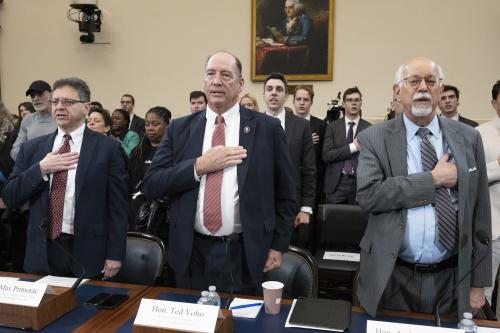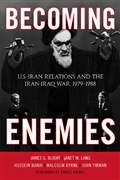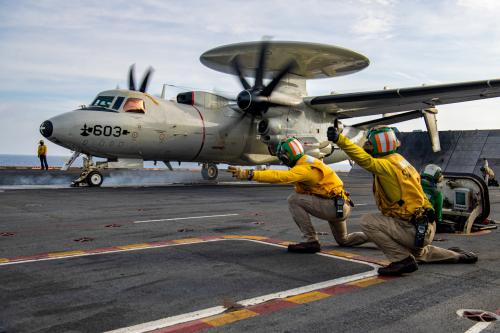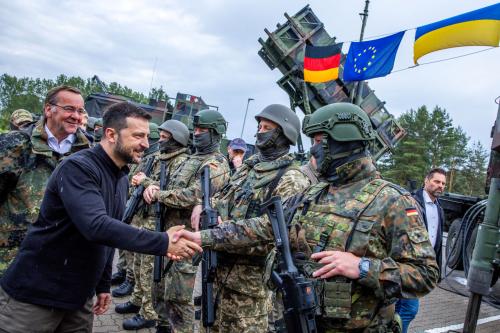

12:30 pm EDT - 2:00 pm EDT
Past Event
12:30 pm - 2:00 pm EDT
1775 Massachusetts Ave., NW
Washington, DC
History is a pivotal tool in strengthening U.S. foreign policy in the Middle East. At a time of heightened tensions with the Islamic Republic of Iran, it is essential that we understand and learn from our past experiences with Tehran.
 On September 24, the Saban Center for Middle East Policy at Brookings hosted a discussion focusing on the book Becoming Enemies: U.S.-Iran Relations During the Iran-Iraq War, 1979-1988. Written by Assistant Professor Hussein Banai of Occidental College, Professors James Blight and Janet Lang of the Balsillie School of International Affairs, Executive Director Jon Tirman of MIT’s Center for International Studies, Deputy Director Malcolm Byrne of the National Security Archive, and Senior Fellow Bruce Riedel of the Saban Center, the book employs critical oral history as a means for detailing the complete scope of the American-Iranian relationship, from the fall of Mohammad Reza Shah in 1979 through the first Gulf War. The book also focuses on individuals that were part of the American decision-making matrix at the time, and captures their firsthand accounts and pivotal documents which detail the United States’ policy during a formative time in Middle Eastern history.
On September 24, the Saban Center for Middle East Policy at Brookings hosted a discussion focusing on the book Becoming Enemies: U.S.-Iran Relations During the Iran-Iraq War, 1979-1988. Written by Assistant Professor Hussein Banai of Occidental College, Professors James Blight and Janet Lang of the Balsillie School of International Affairs, Executive Director Jon Tirman of MIT’s Center for International Studies, Deputy Director Malcolm Byrne of the National Security Archive, and Senior Fellow Bruce Riedel of the Saban Center, the book employs critical oral history as a means for detailing the complete scope of the American-Iranian relationship, from the fall of Mohammad Reza Shah in 1979 through the first Gulf War. The book also focuses on individuals that were part of the American decision-making matrix at the time, and captures their firsthand accounts and pivotal documents which detail the United States’ policy during a formative time in Middle Eastern history.
Hosted by Saban Center Senior Fellow Kenneth Pollack, the discussion focused on the findings of the book, and examined how best to learn from U.S. foreign policy missteps of the past. Framing the discussion, Pollack stressed that the events of the Iran-Iraq War from 1980-1988 set the stage for what we see in the Middle East today. Prior to this conflict, the United States maintained a policy of neutrality in the Persian Gulf. Pollack assessed that during the course of the war, the United States found itself involved in the events of the Persian Gulf in unforeseen ways. The events of this war forced the United States to begin thinking about the internal politics of Iran and Iraq, which policymakers almost steadfastly refused to do so beforehand. Connecting history to contemporary times, Pollack identified the nuclear proliferation problem we see today as an explicit function of the Iran-Iraq War. The war revived Iranian nuclear aspirations which remain a primary topic of debate in the upcoming U.S. elections.
Leading off the discussion among the authors, Riedel stressed that history congruently rhymes with contemporary conflicts. Agreeing with Pollack’s assessment, Mr. Riedel also saw the United States as merely an observer in the initial phases of the Iran-Iraq War; however, the United States quickly morphed into a co-belligerent on the side of the Iraqis. Riedel described the book’s unique collection of insider views, extraordinarily significant documents, and expert commentary detailing the thought process behind U.S. foreign policy. Riedel focused his commentary on six distinct lessons that America must learn from the Iran-Iraq War: Iran is a difficult country to intimidate and leverage; Iran is not a suicidal state, although it may employ the concept and practice of martyrdom to pursue foreign policy goals; ending the Iran-Iraq War turned out to be much harder than anticipated; the advice given to the United States by its allies in the Middle East was consistently catastrophic; the United States should not have expected any gratitude when the war culminated, and, rather, should have been prepared for blame from all sides. Riedel emphasized the overarching historical message behind the events of the Iran-Iraq War, namely that any war with Iran will be an exhaustive, destructive, and precarious undertaking. Iran will not surrender easily, and the threshold for relative peace was set dangerously high during the Iran-Iraq War. Any future conflict with the Iranians involving nuclear weapons would be amazingly ugly.
Lang detailed the critical oral history component of the authors’ research. Lang described how this type of oral history seeks to choose foreign policy failures of the past that have strong relevance to contemporary U.S. policy decisions. Lang detailed three essential components of gathering critical oral history: seeking the recollections of those involved firsthand in the decision-making apparatus, the significance of hard documents which can create a “time machine” to go back in history, and the input of scholars to complete the research. Lang also stressed the need to find individuals whose curiosity trumps their fear, and are willing to openly discuss their historical missteps.
Blight, also focusing on the critical oral history process, described a conference in Italy in 2007 that provided a platform for those involved in the decision-making process to discuss their decisions during the Iran-Iraq War. Blight underlined the necessity for this type of context as a means to develop critical oral history: one that provides a platform for primary players to discuss their thought processes to individuals who will handle it responsibly. This type of “honest brokerage,” Blight emphasized, is a critical aspect of developing an effective critical oral history.
Byrne focused on the trove of illuminating documents discovered in the researching of Becoming Enemies, emphasizing the significance of documents in painting a comprehensive picture when historically examining the Iranian-American relationship. He described, in detail, a discovered CIA memo signed by then-Director Stansfield Turner on September 17, 1980, warning of an extremely near conflict. This example demonstrated the top-level awareness of the events happening on the ground. Byrne also detailed a document of then-Secretary of State Alexander Haig’s talking points after his first trip to the region in 1981, which included references to a discussion with Saudi officials in which it was suggested that Jimmy Carter gave Saddam Hussein a “green light” to invade Iran. Describing this as potential smoking-gun evidence, Byrne emphasized the political, psychological, and international relations ripples that can emanate from just a simple sentence. Lastly, Byrne described a State Department memo, “Analysis of Possible U.S. Shift from a Position of Strict Neutrality” that was released on October 7, 1983. Ironically, from July 1982 onwards, the United States had already shifted from a position of neutrality to what was essentially a position of co-belligerency on the Iraqi side. Byrne questioned the State Department’s thinking in producing this analysis when the policy had already seemingly shifted. Byrne concluded by underlining the necessity of exploring the documents of both sides. There is a wealth of material outside the American archival systems, and Byrne argued that in order to accurately construct a critical oral history, one must explore all perspectives.
Banai brought the discussion closer to the present day, referencing the Arab Awakening and its ripples throughout the region. Banai compared a revolution to a hurricane: not the organized chaos of war, but a force that enters town and replaces the known while leaving some debris and remnants of the old. Banai argued that the Iranian revolution was no exception, and that some of its after-effects are being brought to mind as the dust of the Arab Awakening is beginning to settle – particularly in Egypt and Tunisia. Banai described a steep learning curve in the beginning of revolutions; whenever a new regime takes power, young revolutionaries occupy positions they may not be completely qualified for. Furthermore, there are fixed offices and shifting personalities moving in and out. Particularly during the Iranian revolution, the Iranian political structure was very much in flux, and the United States intelligence apparatus attributed powers to the incorrect people, misjudging the personal relationships within the Iranian political sphere. These personality politics, compounded with a steep learning curve, presented the United States and Iran with very different foreign policies. When dealing with today’s reality, Banai insisted that understanding internal hierarchies and the domestic power dynamics in Iran is necessary. He also stressed the need to observe the actions, not the words, of the realists and the more ideologically driven revolutionaries. By examining these individuals through an analytical lens, Banai argued misconception could be minimized in any future conflicts.
During the question-and-answer segment of the luncheon, Riedel touched on the implications of the Iranian hostage crisis on U.S. foreign policy during the Iran-Iraq War. Riedel speculated that the United States’ hesitation in ending the Iran-Iraq War stemmed from its desire to seek revenge for the hostage crisis of 1979. He concluded the luncheon by reminding participants of how much it took to compel the Iranians to sign a ceasefire agreement. It took a myriad of Iraqi divisions crossing into Iranian soil, the United States’ continuous bombardment of Iranian airspace, and the realistic fear of a chemical weapon attack delivered via Scud missiles. Riedel stressed that, when thinking about a future conflict with Iran, policymakers must keep in mind this dangerously high set of standards. History does not always repeat itself, but by understanding the parallels between past and present, policymakers can make more calculated decisions with regards to the Islamic Republic of Iran and the rest of the Middle East during this time of great fluidity.
12:30 pm - 2:00 pm
On September 24, the Saban Center for Middle East Policy at Brookings hosted a discussion focusing on the book Becoming Enemies: U.S.-Iran Relations During the Iran-Iraq War, 1979-1988.

George Ingram, Sally Paxton
February 21, 2025

Michael E. O’Hanlon
February 21, 2025

Steven Pifer
February 19, 2025